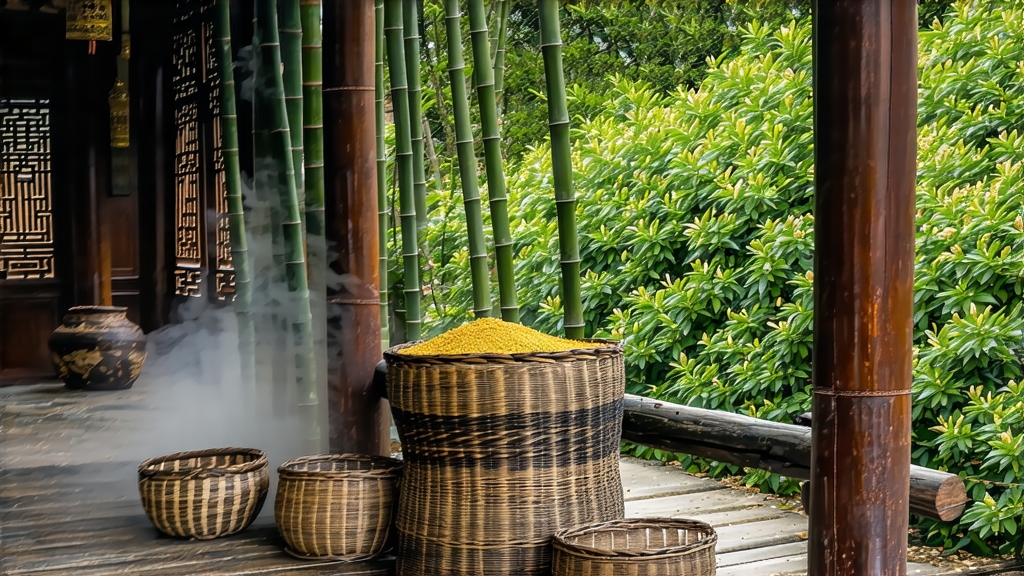
Tucked high in the mist-veiled Dabie Mountains of western Anhui Province, Huoshan Huangya has quietly embodied the elegance of China’s rarest tea family for more than fourteen centuries. While green teas grab global headlines and pu-erhs age into investment trophies, this “yellow bud” tea survives as a living fossil of dynastic refinement, its subtle amber liquor once reserved for Tang emperors and later celebrated in the Song-era treatise “Da Guan Cha Lun”. Today only a few hundred artisan households still possess the patience—and the municipal protection order—to coax its signature “yellow leaf, yellow soup” from one of the shortest picking windows in agriculture: seven mist-cooled mornings between Qingming and Grain Rain when the buds are still closed pearls no longer than a knuckle.
Huoshan County’s microclimate is the first secret. At 800–1 200 m elevation, night temperatures plunge ten degrees below the daytime valley, forcing the tea bush to store amino acids that later translate into sweet, almost milky thickness. Frequent cloud diffuses sunlight, raising chlorophyll-b and carotenoids; the result is a bud so pale it looks white, yet the leaf vein already carries a citrine undertone that foretells the transformation to come.
The cultivars themselves are hyper-local. “Jin Ji Zhong” (Golden Chicken Bush) and “Xiao Ye Zhong” (Small-Leaf Race) have been selected over centuries for low polyphenol bitterness and high soluble sugars. Cuttings are still grafted onto mountain tea trees older than the growers’ grandparents, preserving a genetic bank that scientists at Anhui Agricultural University now call a “cold-zone heirloom archive”.
Picking rules are draconian: one bud, one very small first leaf, no tools, only fingernails to avoid bruise oxidation. A skilled picker fills barely half a bamboo quiver in a dawn, yet 60 000 such sets surrender just one kilogram of finished tea. The harvest must reach the village work-shed before the sun climbs too high; enzymatic life is measured in minutes.
What follows is the least understood, most artisanal stage in all of Chinese tea craft—men huang, literally “sealing yellow”. After a 30-second 160 °C tumble in an iron wok (sha qing) that kills surface oxidase, the buds are wrapped, still hot, in tiny linen bundles and stacked in a bamboo steamer. For the next four hours the tea literally stews in its own residual moisture at 38 °C and 65 % humidity, a micro-fermentation that edges chlorophyll toward pheophytin while forming the unique 3-methylbutanal and β-ionone compounds responsible for Huoshan Huangya’s signature notes of toasted sesame, fresh corn silk, and mountain orchid. Every forty minutes the master unwraps, fluffs, and re-bundles, judging by aroma and tackiness whether the leaf is “breathing” evenly. No thermometer, no timer; the decision is muscle memory passed from mother to daughter.
Once the leaf has turned a uniform pale champagne, it is fired twice more—first over charcoal embers screened by horse-hair mesh, then a final low 60 °C bake that reduces moisture to 5 % while locking in a faint honey finish. The entire cycle stretches across three labor-intensive days, after which the tea must “sleep” in unglazed clay jars for at least a fortnight so the last traces of “fire qi” dissipate. Only then is it considered stable enough to travel.
Western aficionados often confuse the finished leaf with Bai Hao Yin Zhen, but side-by-side the difference is arresting. Huoshan Huangya’s needles are slightly curved like a fisherman’s hook, the down visible yet tinted the color of old parchment; the aroma is not green-bean fresh but warm cereal, almost sourdough. When brewed it abandons all coyness: the liquor shines crystal topaz, brilliant enough to refract light onto a white porcelain gaiwan wall.
Water is the first variable in the cup. The miners of Huoshan historically used spring water dripping from copper-bearing strata; that trace mineral accentuates the tea’s natural glutamate, creating mouth-watering umami. At home, a low-TDS spring water with 30–50 mg L⁻¹ bicarbonate is ideal. Heat to 85 °C—any hotter scalds the bud; any cooler fails to lift the sesame fragrance